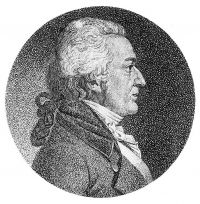Benjamin Smith Barton (Physiognotrace)
Artist/Maker: Christian Gobrecht (1785-1844), after Charles Fevret de Saint-Mémin (1770-1852)
Created: 1820
Materials: stipple engraving
Dimensions: 5.7 (2 1/4 in.)
Location: Tea Room
Owner: The Library Company of Philadelphia
Historical Notes: Jefferson and Benjamin Smith Barton, the physician and botanist, shared an interest in many aspects of natural history and Native American languages. Together with Barton's brother William and his uncle, David Rittenhouse, both were members of the American Philosophical Society. Barton was born in Lancaster, Pennsylvania, and studied medicine in Edinburgh and London, where he became a member of the Royal Medical Society. Upon his return to America, Barton taught natural history and botany at the College of Philadelphia, and later succeeded Benjamin Rush in the chair of medicine at the University of Pennsylvania.[1]
In his 1792 paper to the American Philosophical Society, Barton praised Jefferson's contribution to the study of natural history and renamed Podophyllum diphyllum, a wildflower of eastern North America, Jeffersonia binata in his honor.
In imposing upon this genus the name of Mr. Jefferson, I have had no reference to his political character, or to his reputation for general science, and for literature. My business was with his knowledge of natural history. In the various departments of science, but especially in botany and zoology, the information of this gentleman is equalled by that of few persons in the United-States.[2]
Jefferson had keen respect for Barton and sent Meriwether Lewis to consult with him about botany, natural history, and Native Americans, to prepare for the northwest expedition. He wrote Barton, "I know that the same wish to promote science which has induced me to bring forward this proposition, will induce you to aid in promoting it."[3] After Lewis and Clark's return in 1806, Barton was engaged to compile a scientific report for publication from their journals, but died before completing the work.
Barton and Jefferson believed that the key to discovering the origin of Native Americans was a comparative study of their languages with those of Europe and Asia. They actively sought examples of Native American vocabularies. Barton published his findings in 1797 in a work dedicated to Jefferson, New Views of the Origin of the Tribes and Nations of America.[4] Jefferson planned to publish his comparative vocabularies in 1800, but presidential demands caused him to delay his work on the subject until his retirement. Tragically, most of the fifty vocabularies he had collected over thirty years were destroyed en route from the President's House to Monticello in 1809. Barton had asked Jefferson to send him samples of the vocabularies collected by Lewis and Clark, but these, too, were mostly destroyed. Jefferson shared with his friend Barton "the only morsel of an original vocabulary" that survived: Lewis's record of the Pani language.[5]
- Text from Stein, Worlds, 202
References
- ^ DAB, s.v. "Benjamin Smith Barton."
- ^ Benjamin Smith Barton, "A Letter to Chas. Peter Thumberg. A Botanical Description of the Podophyllum Diphyllum," Transactions of the American Philosophical Society 3 (1793): 342. Jeffersonia binata is now called Jeffersonia diphylla. See Betts, Garden Book, 172-73.
- ^ Jefferson to Barton, February 27, 1803, in PTJ, 39:588-89. Transcription available at Founders Online.
- ^ See Sowerby, 3998; John C. Greene, American Science in the Age of Jefferson (Ames, Iowa: Iowa State University, 1984), 376-85.
- ^ Jefferson to Barton, September 21, 1809, in PTJ:RS, 1:555-57. Transcription available at Founders Online.
